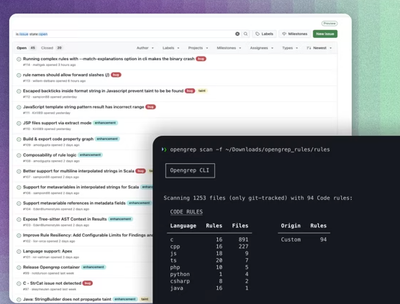
Research
Security News
Lazarus Strikes npm Again with New Wave of Malicious Packages
The Socket Research Team has discovered six new malicious npm packages linked to North Korea’s Lazarus Group, designed to steal credentials and deploy backdoors.
ember-cli-deploy-cloudformation
Advanced tools
An ember-cli-deploy plugin to create/update an AWS CloudFormation stack
An Ember CLI Deploy plugin to create/update an AWS CloudFormation stack before deploying to it
AWS CloudFormation is Amazon's implementation of infrastructure as code, which lets you create, update, provision and delete stacks of AWS resources (e.g. EC2 instances, S3 buckets, CloudFront distributions etc.), described by a single configuration file.
For details on how CloudFormation works and how to write a template file, please visit the official CloudFormation Documentation. Also check the Examples section for some example configurations for common Ember deployment scenarios.
This is an Ember CLI addon that adds a plugin to the Ember CLI Deploy pipeline to create or update a CloudFormation stack as part of the Ember CLI Deploy pipeline. It does not actually deploy any artefacts itself, this is where any of the existing plugins that work with AWS resources come into play. Here are some that should work just fine:
ember-cli-deploy-s3ember-cli-deploy-s3-indexember-cli-deploy-s3-packember-cli-deploy-cloudfrontember-cli-deploy-elastic-beanstalkember-cli-deploy-fastboot-app-server-awsThis allows you to create the AWS resources and deploy your app to them in one single ember deploy command.
For example you could easily deploy a feature branch to a new staging environment just for this feature and delete it
afterwards, without any manual setup work.
The AWS CLI allows you to interact with CloudFormation, but suffers from a few caveats when integrating it into a CI/CD pipeline:
Run the following command in your terminal:
ember install ember-cli-deploy-cloudformation
Ember is about shared solutions to common problems. And this applies here as well. Instead of figuring all the details of a useful CloudFormation stack, this section will feature a few examples to get you going quickly:
This section is still a work in progess. If you have some templates you can share, please submit a PR so others can benefit from your experience as well!
The configuration of this plugin takes place in three steps:
Create a CloudFormation template, that defines all the AWS resources in your stack. Consult the CloudFormation documentation for more information.
Usually you will want to put this file under version control, so you can create it in your app's root folder as e.g.
cfn.yaml, git add cfn-yaml, and reference it in the plugin configuration as
templateBody: 'file://cfn.yaml.
Add the required configuration to your config/deploy.js.
See Configuration Options below for all available configuration options. For detailed information on how configuration of plugins works, please refer to the Plugin Documentation.
Here is an example of a configuration. It uses environment variables to inject all parameters that are variable:
{
cloudformation: {
accessKeyId: process.env.AWS_ACCESS_KEY_ID,
secretAccessKey: process.env.AWS_SECRET_ACCESS_KEY,
region: 'eu-central-1',
templateBody: 'file://cfn.yaml',
capabilities: ['CAPABILITY_IAM'],
parameters: {
DomainName: process.env.CFN_DOMAINNAME,
Certificate: process.env.CFN_CERTIFICATE,
HostedZoneId: process.env.CFN_HOSTEDZONEID
}
}
}
A CloudFormation template let's you define so called "Outputs". These are commonly values, which were not available before creating the stack. So for example these could be some resource properties, like the name of an S3 bucket created by CloudFormation or the URL of a CloudFront distribution.
Some of these you will have to pass to other Ember CLI Deploy plugins, so they can actually deploy your app to the
infrastructure that CloudFormation has created for you. A common example would be to pass the S3 bucket to
ember-cli-deploy-s3.
This plugin will write all outputs of the processed template to the Ember CLI Deploy context, at the path
cloudformation.outputs as simple hash with the name of the output as the key. As Ember CLI Deploy allow you to
configure plugins not only with static values, but also with functions that receive the context, you can easily
pass the outputs to any other plugin. Here the afore-mentioned S3 plugin will receive the name of the bucket, that was
defined in the CloudFormation template output as AssetsBucket:
{
cloudformation: {
...
},
s3: {
accessKeyId: process.env.AWS_ACCESS_KEY_ID,
secretAccessKey: process.env.AWS_SECRET_ACCESS_KEY,
bucket(context) {
return context.cloudformation.outputs.AssetsBucket;
},
region: 'eu-central-1'
}
}
The AWS access key for the user that has the ability to work with CloudFormation. If this is left undefined, the normal AWS SDK credential resolution will take place.
Default: undefined
The AWS secret for the user that has the ability to work with CloudFormation. This must be defined when accessKeyId is defined.
Default: undefined
The AWS profile as definied in ~/.aws/credentials. If this is left undefined,
the normal AWS SDK credential resolution will take place.
Default: undefined
The region to create the CloudFormation stack in.
Default: undefined
Moreover all parameters supported by the AWS CloudFormation SDK will be passed when creating/updating the stack. See the AWS SDK docs for a complete reference.
Note: the plugin will let you write parameters in the more usual camelcase style, and map them to the pascal case style that AWS expects. So instead of writing
StackName, you can usestackName. Also for thetagsandparametersproperties, specify them as normal JavaScript hashes (e.g.tags: { key: 'value' }) instead of the original AWS syntax!
Here is a list of the commonly used CloudFormation parameters:
The name of the CLoudFormation stack.
Default: <appName>-<deployTarget>, e.g. myApp-production
The CloudFormation template body as a string (JSON or YAML). Instead of inlining your template, the file:// protocol
is also supported to reference a template file on disk, e.g. file://path/to/cfn.yaml (relative to your app's root folder)
Either templateBody or templateURL is required!
Default: undefined
The location of a CloudFormation template (JSON or YAML). The URL must point to a template that is located in an Amazon S3 bucket.
Either templateBody or templateURL is required!
Default: undefined
An array of required capabilites, e.g. ['CAPABILITY_IAM'] for working with IAM roles, user, policies etc.
Default: undefined
A hash of input parameters as expected by your CloudFormation template.
Note: specify them as normal JavaScript hashes (e.g. parameters: { name: 'value' }) instead of the unusual AWS syntax!
parameters: {
Domain: 'example.com'
}
Default: undefined
v1.0.0 (2022-06-02)
FAQs
An ember-cli-deploy plugin to create/update an AWS CloudFormation stack
The npm package ember-cli-deploy-cloudformation receives a total of 114 weekly downloads. As such, ember-cli-deploy-cloudformation popularity was classified as not popular.
We found that ember-cli-deploy-cloudformation demonstrated a not healthy version release cadence and project activity because the last version was released a year ago. It has 3 open source maintainers collaborating on the project.
Did you know?

Socket for GitHub automatically highlights issues in each pull request and monitors the health of all your open source dependencies. Discover the contents of your packages and block harmful activity before you install or update your dependencies.

Research
Security News
The Socket Research Team has discovered six new malicious npm packages linked to North Korea’s Lazarus Group, designed to steal credentials and deploy backdoors.

Security News
Socket CEO Feross Aboukhadijeh discusses the open web, open source security, and how Socket tackles software supply chain attacks on The Pair Program podcast.

Security News
Opengrep continues building momentum with the alpha release of its Playground tool, demonstrating the project's rapid evolution just two months after its initial launch.